Exploring the Impacts of Driving Environment on Crashes in Tunnel–Bridge–Tunnel Groups: An Eight-Zone Analytic Approach
Abstract
1. Introduction
2. Materials and Methods
2.1. Definition of Tunnel–Bridge–Tunnel Groups
2.1.1. Tunnels
2.1.2. Bridges
2.2. Zone Division
- Zone 1 (Z1), access zone: the first 150 m in front of the first tunnel;
- Zone 2 (Z2), threshold zone: the first 100 m inside the tunnel;
- Zone 3 (Z3), transition zone: the next 300 m inside the tunnel;
- Zone 4 (Z4), interior zone: the remainder of the tunnel;
- Zone 5 (Z5), exit zone: the 60 m in front of the portal of the tunnel;
- Zone 6 (Z6), connecting zone: the first 150 m behind the first tunnel or in front of the second tunnel;
- Zone 7 (Z7), middle zone: the remainder of the bridge; and
- Zone 8 (Z8), parting zone: the first 150 m behind the second tunnel.
2.3. Data Basis and Preparation
3. Results and Discussion
3.1. Crashes and Separation Distance between Structures
3.2. Crash Rate in Road Zones and Types
3.2.1. General Analysis
3.2.2. Crash Analysis of Tunnels
3.3. Crashes and Travel Process
3.4. Crashes and Bridge–Tunnel Ratios
4. Conclusions
Author Contributions
Funding
Institutional Review Board Statement
Informed Consent Statement
Data Availability Statement
Conflicts of Interest
References
- 2019 Statistics Bulletin about the Development of Transportation Industry of China; Ministry of Transport of the People’s Republic of China: Beijing, China, 2020.
- Chen, F.; Peng, H.R.; Ma, X.X.; Liang, J.Y.; Hao, W.; Pan, X.D. Examining the safety of trucks under crosswind at bridge-tunnel section: A driving simulator study. Tunn. Undergr. Space Technol. 2019, 92, 1–9. [Google Scholar] [CrossRef]
- Chen, P.Y.; Chen, F.; Zhang, L.; Ma, X.X.; Pan, X.D. Examining the influence of decorated sidewall in road tunnels using fMRI technology. Tunn. Undergr. Space Technol. 2020, 99, 1–6. [Google Scholar] [CrossRef]
- He, S.Y.; Liang, B.; Pan, G.B.; Wang, F.; Cui, L.L. Influence of dynamic highway tunnel lighting environment on driving safety based on eye movement parameters of the driver. Tunn. Undergr. Space Technol. 2017, 67, 52–60. [Google Scholar] [CrossRef]
- Human Factors and Road Tunnel Safety Regarding Users; PIARC: Paris, France, 2008.
- Cantisani, G.; D’Andrea, A.; Moretti, L. Natural lighting of road pre-tunnels: A methodology to assess the luminance on the pavement—Part I. Tunn. Undergr. Space Technol. 2018, 73, 37–47. [Google Scholar] [CrossRef]
- Cantisani, G.; D’Andrea, A.; Moretti, L. Natural lighting of road pre-tunnels: A methodology to assess the luminance on the pavement—Part II. Tunn. Undergr. Space Technol. 2018, 73, 170–178. [Google Scholar] [CrossRef]
- Moretti, L.; Cantisani, G.; Mascio, P.D. Management of road tunnels: Construction, maintenance and lighting costs. Tunn. Undergr. Space Technol. 2016, 51, 84–89. [Google Scholar] [CrossRef]
- Peña-García, A.; López, J.; Grindlay, A. Decrease of energy demands of lighting installations in road tunnels based in the forestation of portal surroundings with climbing plants. Tunn. Undergr. Space Technol. 2015, 46, 111–115. [Google Scholar] [CrossRef]
- Peña-García, A. The impact of lighting on drivers well-being and safety in very long underground roads: New challenges for new infrastructures. Tunn. Undergr. Space Technol. 2018, 80, 38–43. [Google Scholar] [CrossRef]
- Peña-García, A. Optical coupling of grouped tunnels to decrease the energy and materials consumption of their lighting installations. Tunn. Undergr. Space Technol. 2019, 9, 1–6. [Google Scholar] [CrossRef]
- Sun, Z.Y.; Liu, S.; Li, D.X.; Tang, B.; Fang, S. Crash analysis of mountainous freeways with high bridge and tunnel ratios using road scenario-based discretization. PLoS ONE 2020, 15, e0237408. [Google Scholar] [CrossRef]
- Wang, J.; Amjad, P.; Wang, Z.; Han, C. Crash analysis of Chinese freeway tunnel groups using a five-zone analytic approach. Tunn. Undergr. Space Technol. 2018, 82, 358–365. [Google Scholar] [CrossRef]
- Bassan, S. Overview of traffic safety aspects and design in road tunnels. IATSS Res. 2016, 40, 35–46. [Google Scholar] [CrossRef]
- Lemke, K. Road safety in tunnels. Transp. Res. Rec. 2000, 1940, 170–174. [Google Scholar] [CrossRef]
- Huang, H.L.; Peng, Y.Y.; Wang, J.; Luo, Q.Z.; Li, X. Interactive risk analysis on crash injury severity at a mountainous freeway with tunnel groups in China. Accid. Anal. Prev. 2018, 111, 56–62. [Google Scholar] [CrossRef] [PubMed]
- Ma, Z.L.; Shao, C.F.; Li, X. Analysis of influence factors on severity for traffic accidents of expressway tunnel. J. Beijing Jiaotong Univ. 2009, 33, 52–55. [Google Scholar]
- Ma, Z.L.; Chien, I.J.; Dong, C.J.; Hu, D.W.; Xu, T. Exploring factors affecting injury severity of crashes in freeway tunnels. Tunn. Undergr. Space Technol. 2016, 59, 100–104. [Google Scholar] [CrossRef]
- Hou, Q.Z.; Tarko, A.P.; Meng, X.H. Analyzing crash frequency in freeway tunnels: A correlated random parameters approach. Accid. Anal. Prev. 2018, 111, 94–100. [Google Scholar] [CrossRef] [PubMed]
- Caliendo, C.; De Guglielmo, M.L.; Guida, M. A crash-prediction model for road tunnels. Accid. Anal. Prev. 2013, 55, 107–115. [Google Scholar] [CrossRef]
- Duan, M.M.; Tang, B.M.; Liu, T.Z.; Hu, Y.X. Accident prediction model of freeway with high ratio of bridges and tunnels based on multivariate nonlinear regression. Highway Eng. 2018, 43, 122–126. [Google Scholar]
- Amundsen, F.H.; Ranes, G. Studies on traffic accidents in Norwegian road tunnels. Tunn. Undergr. Space Technol. 2000, 15, 3–11. [Google Scholar] [CrossRef]
- Ma, Z.L.; Shao, C.F.; Zhang, S.R. Characteristics of traffic accidents in Chinese freeway tunnels. Tunn. Undergr. Space Technol. 2009, 24, 350–355. [Google Scholar] [CrossRef]
- Yeung, J.S.; Wong, Y.D. Road traffic accidents in Singapore expressway tunnels. Tunn. Undergr. Space Technol. 2013, 38, 534–541. [Google Scholar] [CrossRef]
- Brandt, R.; Schubert, M.; Høj, N.P. On risk analysis of complex road-tunnel systems. In Proceedings of the 6th International Conference on Tunnel Safety and Ventilation, Graz, Austria, 23–25 April 2012; pp. 41–48. [Google Scholar]
- Lu, L.J.; Lu, J.; Xing, Y.Y.; Wang, C.; Pan, F.Q. Statistical analysis of traffic accidents in Shanghai River crossing tunnels and safety countermeasures. Discret. Dyn. Nat. Soc. 2014, 1–7. [Google Scholar] [CrossRef]
- Nussbaumer, C. Comparative Analysis of Safety in Tunnels; Young Researchers Seminar: Brno, Czech Republic, 2007; pp. 1–9. [Google Scholar]
- Guide for the Lighting of Road Tunnels and Underpasses (CIE 88-2004); Commission Internationale de L’éclairage: Vienna, Austria, 2004.
- Hu, J.B.; Wang, W.L.; Zhang, S.R. Safety Analysis of Car Drivers’ Fixation Characteristics on Freeways. J. Southwest Jiaotong Univ. 2012, 47, 299–305. [Google Scholar]
- Du, Z.G.; Huang, F.M.; Yan, X.P.; Pan, X.D. Light and dark adaption time based on pupil area variation at entrance and exit areas of highway tunnel. J. Highway Transp. Res. Dev. 2013, 30, 98–102. [Google Scholar] [CrossRef]
- Guidelines for Design of Lighting of Highway Tunnels (JTG/T D70/2-01-2014); Ministry of Transport of the People’s Republic of China: Beijing, China, 2014.
- Highway Engineering Technique Standard (JTG B01-2014); Ministry of Transport of the People’s Republic of China: Beijing, China, 2014.
- Wu, H.B.; Zhen, D.X.; Zhou, R.G. Safety evaluation techniques for tunnel-bridge linkage sections on freeways in mountainous areas. J. Highway Transp. Res. Dev. 2012, 29, 125–132. [Google Scholar]
- Hu, S.F. Traffic accident characteristics and mechanism analysis of mountain highway tunnel group. Highway 2016, 5, 134–138. [Google Scholar]



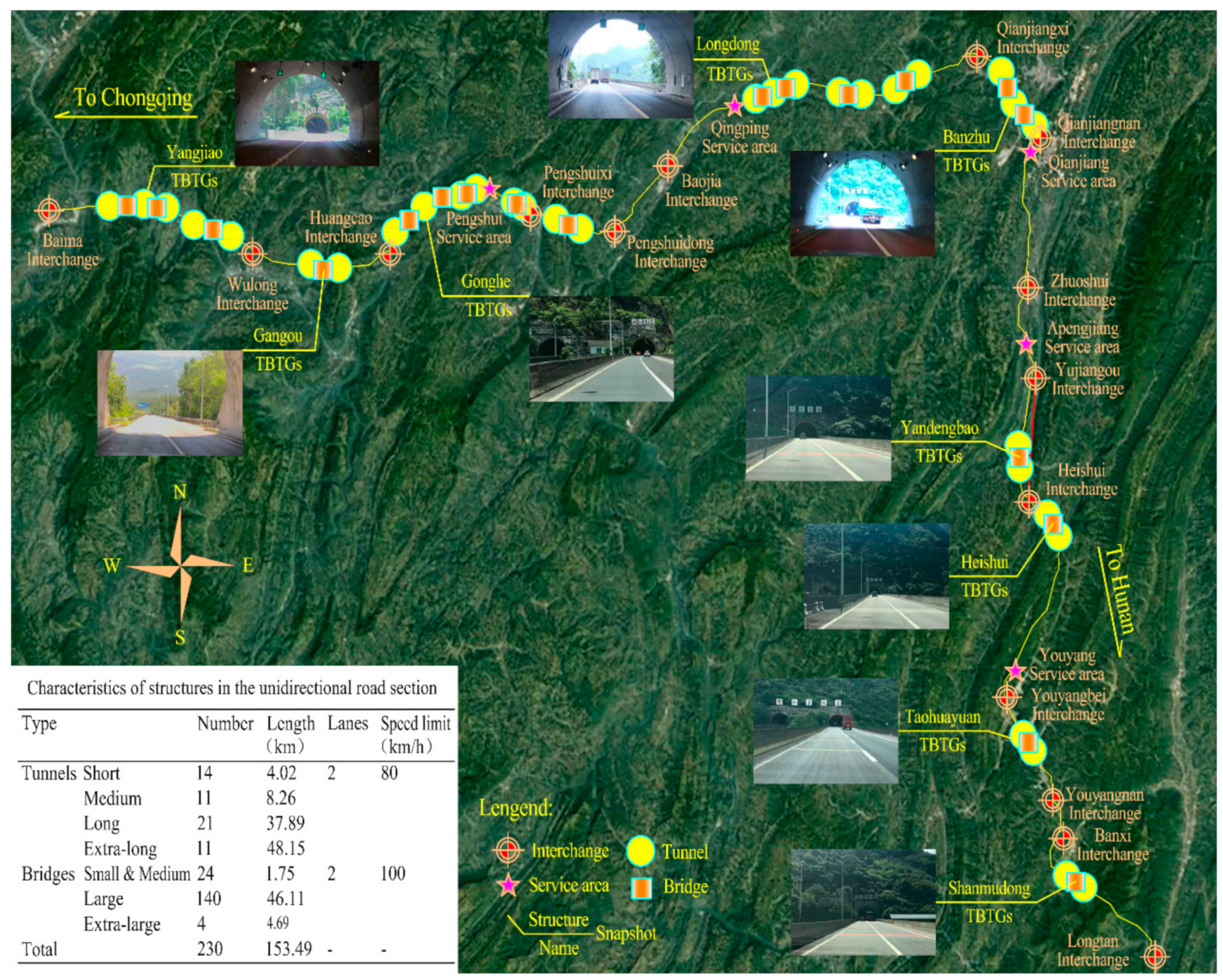
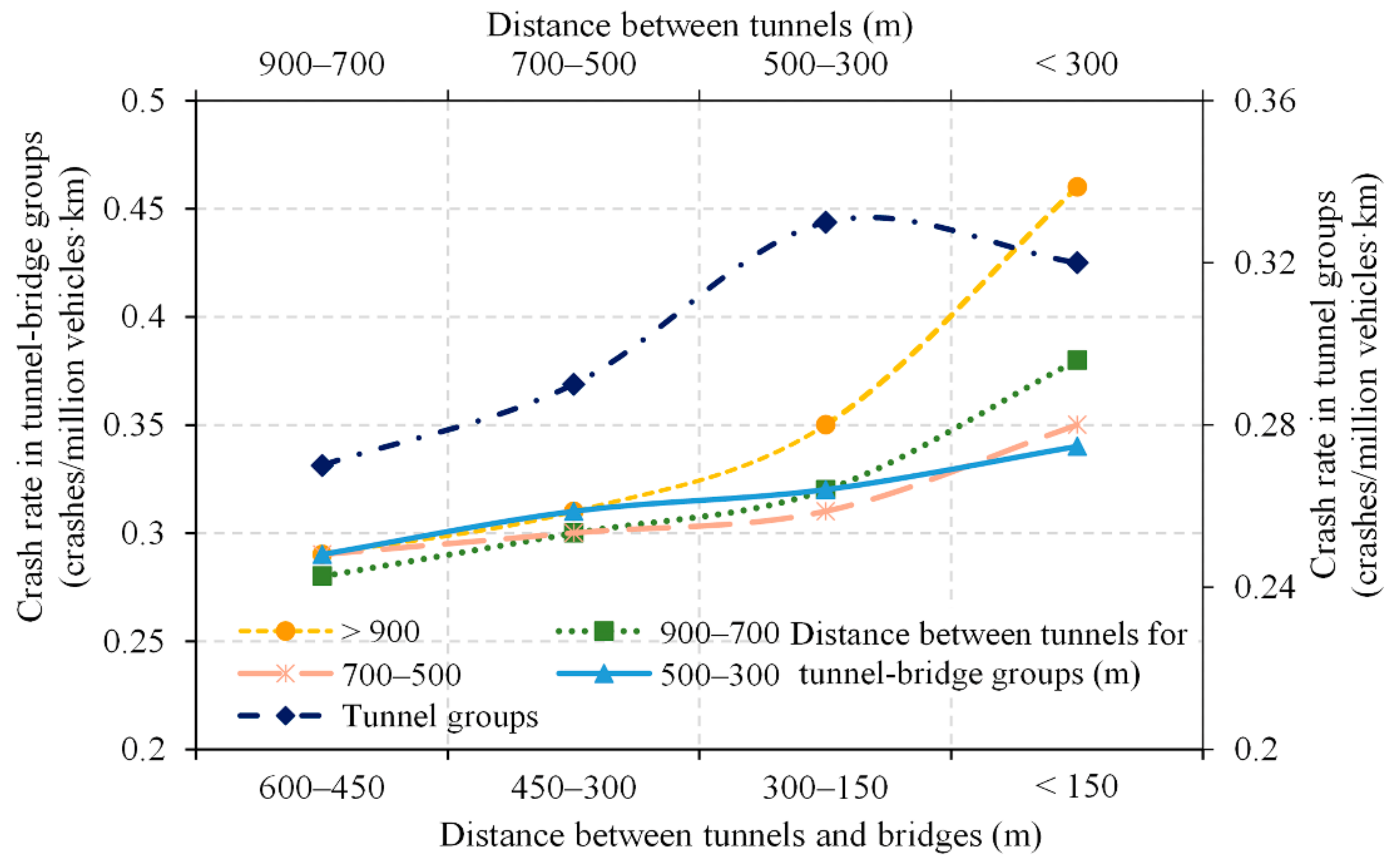
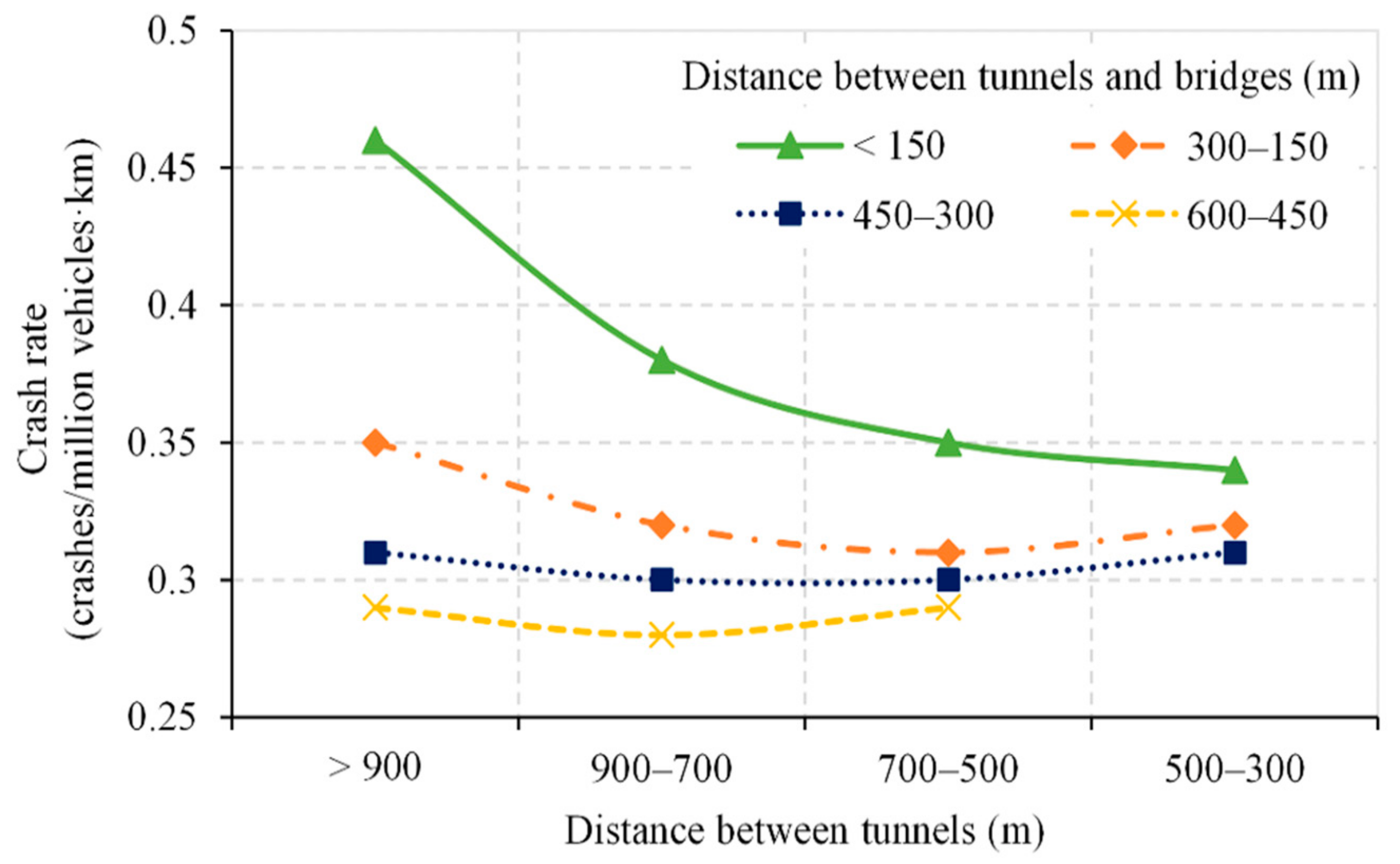
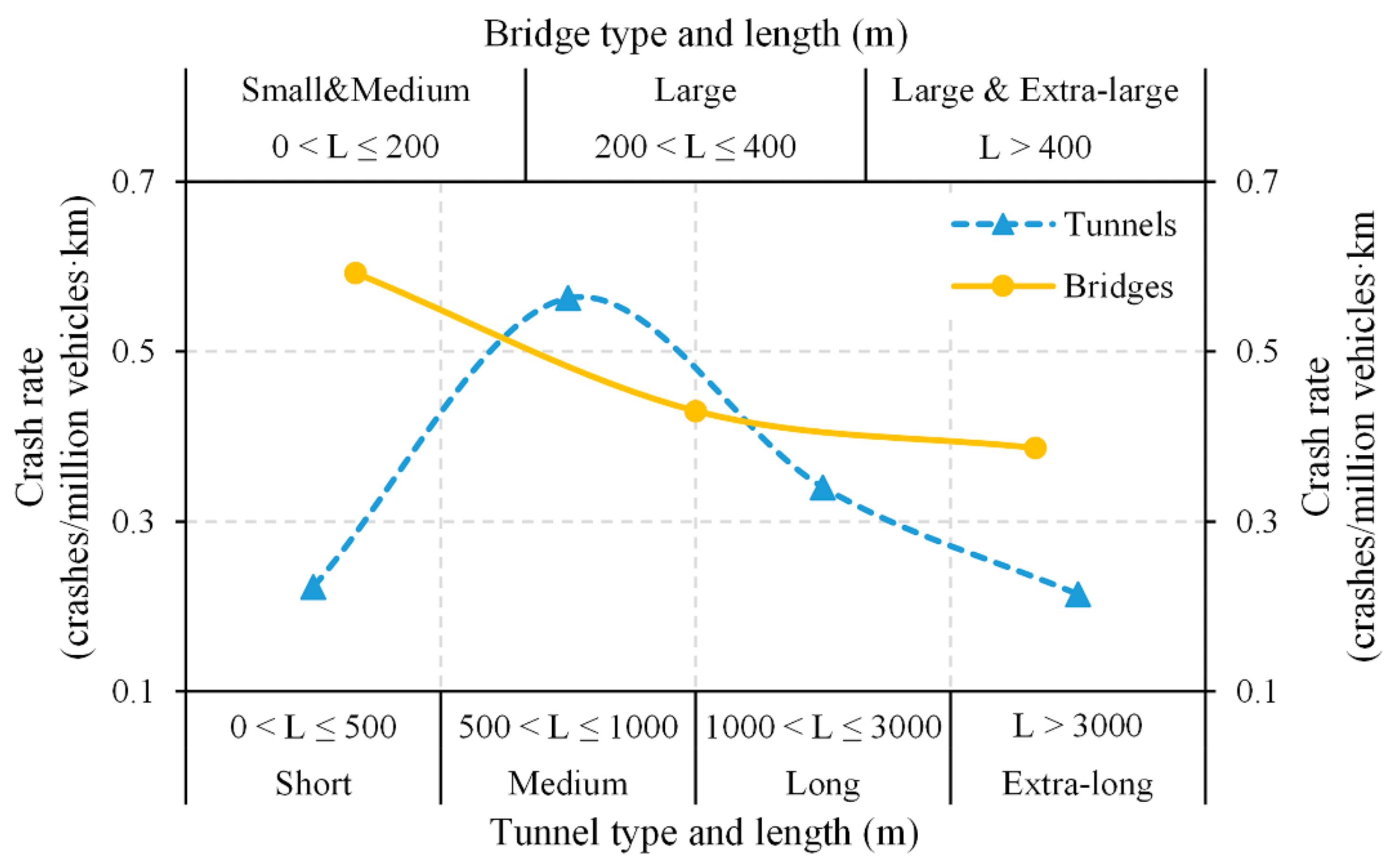
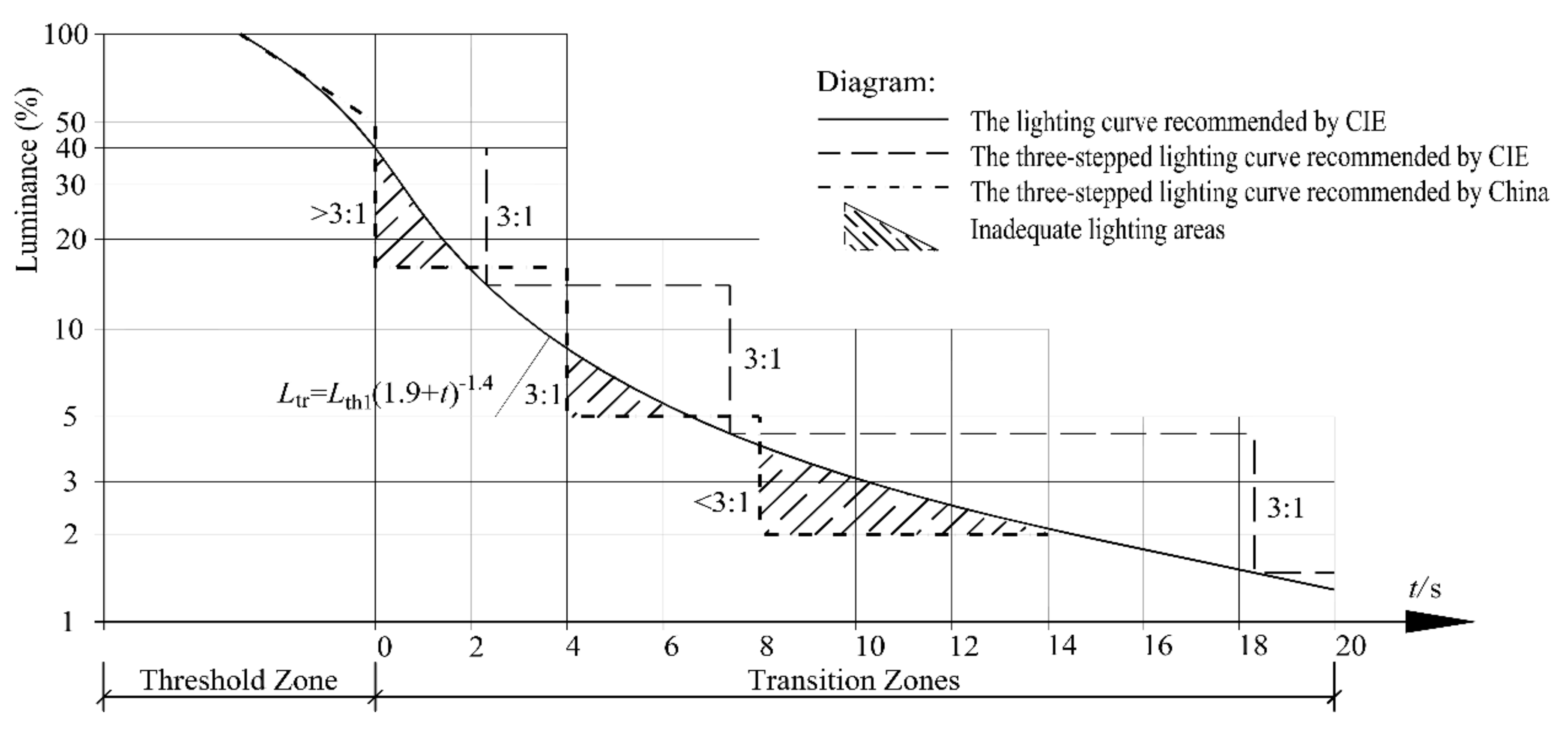
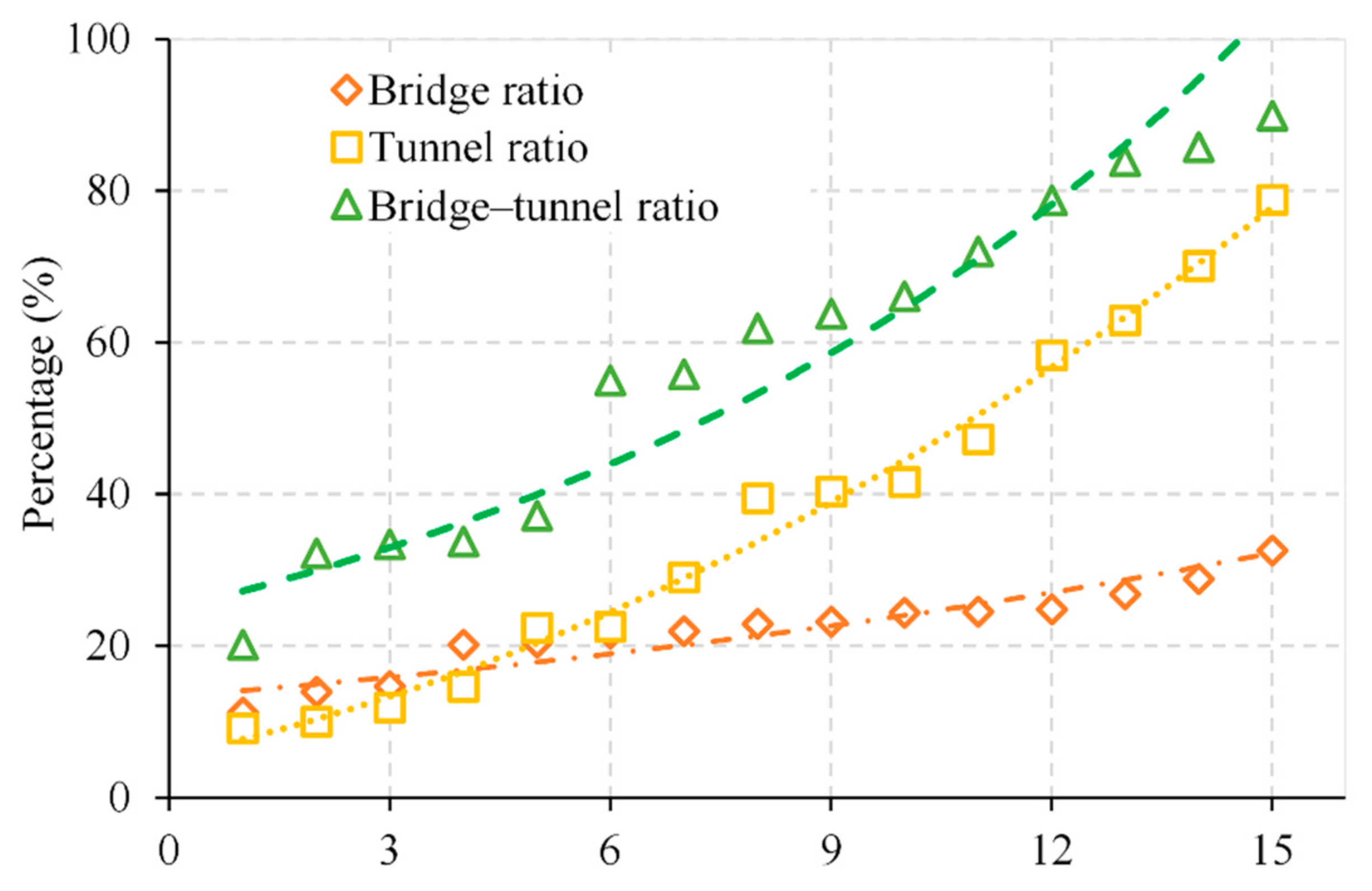
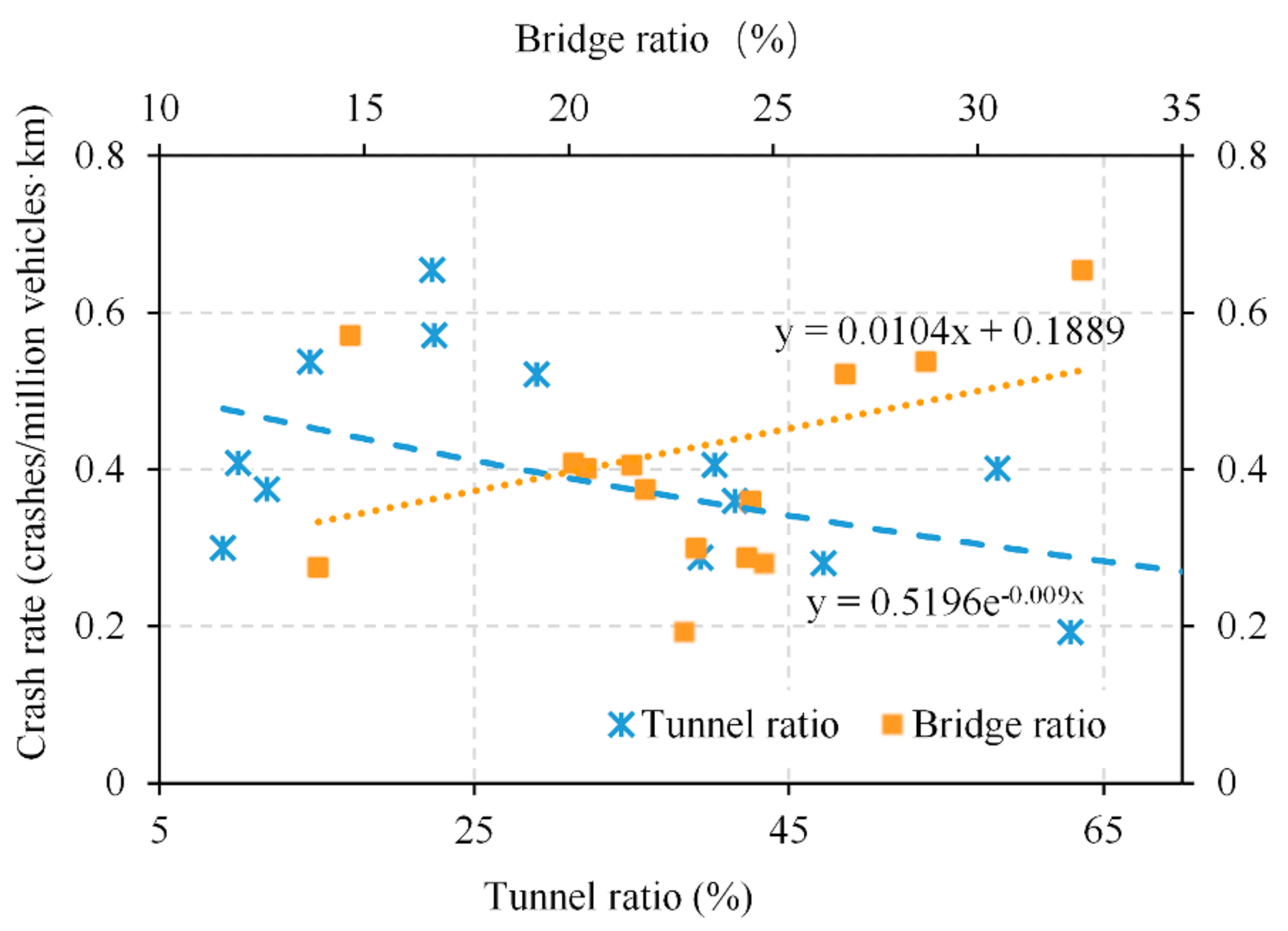
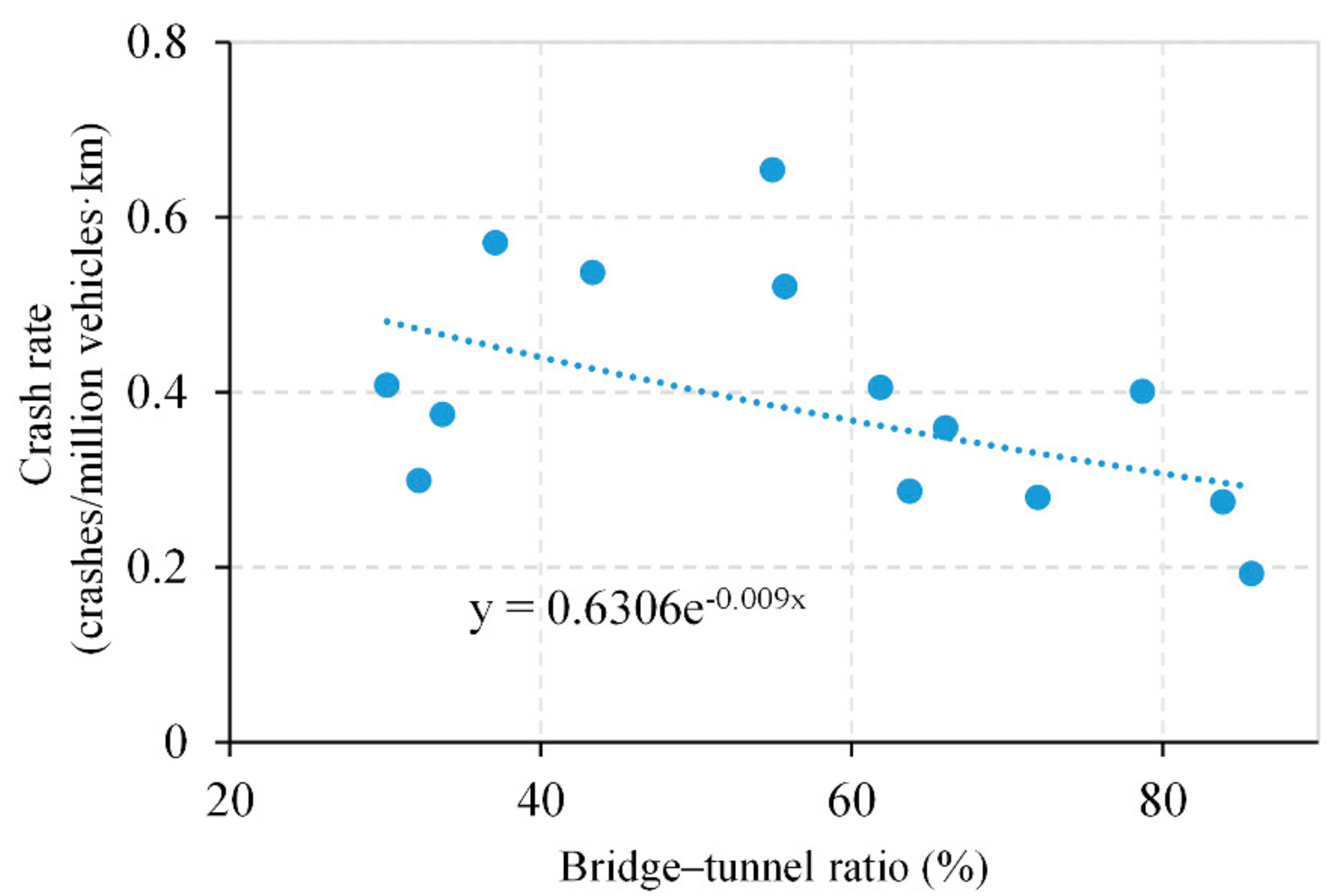
| Research | Tunnel | Crash | Access Zone | Entrance Zone | Transition Zone | Inner Zone | Exit Zone | Parting Zone | Total | |||
|---|---|---|---|---|---|---|---|---|---|---|---|---|
| Sum | Type | Years | Sum | Type | ||||||||
| Amundsen [22] | 587 | All tunnels | 1992–1996 | 499 | Injury | 0.3 | 0.23 | 0.16 | 0.1 | 0.23 | 0.3 | 0.13 |
| Ma et al. [23] | 8 | Freeway tunnels | 2003–2004 | 134 | All | 0.56 | 0.53 | 0.58 | 0.45 | 0.53 | 0.56 | 0.5 |
| Yeung 1 [24] | 6 | Expressway tunnels | 2009–2011 | 608 | All | 52 | 35 2 | 5 | 10 | 16 | – | |
| Wang et al. [13] | 6 | Tunnel groups | 2012–2016 | 442 | All | 1.34 | 2.57 | 2.98 3 | 1.77 | 1.34 4 | 1.72 | |
| Type | Characteristics | Maximum Safety-Critical Distance (m) | ||
|---|---|---|---|---|
| Tunnel-Bridge | Bridge before tunnel | 650 | ||
| Tunnel before bridge | Tunnel type | Short | 400 | |
| Medium | 450 | |||
| Long | 500 | |||
| Extra-long | 550 | |||
| Tunnel-Tunnel | The first tunnel type | Short | 750 | |
| Medium | 800 | |||
| Long | 850 | |||
| Extra-long | 900 | |||
| Road Type | Length (km) | AADT 1 (vehicles/day) | Travel 2 (mill vehicles·km/yr) | Number of Crashes | Crashes Rates 3 (crashes/mill vehicles·km) |
|---|---|---|---|---|---|
| Zone 1 | 1.65 | 14,499 | 8.73 | 26 | 0.98 |
| Zone 2 | 2.60 | 14,499 | 13.76 | 19 | 0.46 |
| Zone 3 | 6.80 | 14,713 | 36.52 | 53 | 0.49 |
| Zone 4 | 33.88 | 14,878 | 183.97 | 166 | 0.30 |
| Zone 5 | 1.56 | 14,499 | 8.26 | 10 | 0.42 |
| Zone 6 | 4.50 | 14,499 | 23.81 | 31 | 0.44 |
| Zone 7 | 7.75 | 14,256 | 40.34 | 57 | 0.47 |
| Zone 8 | 1.65 | 14,499 | 8.73 | 15 | 0.59 |
| Entire road | 60.39 | 14,499 | 324.12 | 378 | 0.39 |
| Tunnels | 44.84 | 14,818 | 242.50 | 248 | 0.34 |
| Bridges | 8.58 | 13,603 | 42.59 | 61 | 0.48 |
| Ordinary sections | 7.38 | 14,406 | 38.78 | 69 | 0.59 |
| Zone | The First Passed Tunnel (proportion) | The Second Passed Tunnel (proportion) | χ2 | p-Value |
|---|---|---|---|---|
| Zone 1 | 35 (0.69) | 16 (0.31) | 4.302 | 0.045 |
| Zone 2 | 14 (0.64) | 8 (0.36) | 0.578 | 0.447 |
| Zone 3 | 41 (0.67) | 20 (0.33) | 3.967 | 0.046 |
| Zone 4 1 | 61 (0.49) | 63 (0.51) | 3.783 | 0.052 |
| Zone 5 | 5 (0.42) | 7 (0.58) | 1.024 | 0.312 |
| Zone 6 | 15 (0.42) | 21 (0.58) | 3.344 | 0.067 |
| Inside tunnel | 121 (0.55) | 98 (0.45) | 0.124 | 0.724 |
| Outside tunnel | 50 (0.57) | 37 (0.43) |
Publisher’s Note: MDPI stays neutral with regard to jurisdictional claims in published maps and institutional affiliations. |
© 2021 by the authors. Licensee MDPI, Basel, Switzerland. This article is an open access article distributed under the terms and conditions of the Creative Commons Attribution (CC BY) license (http://creativecommons.org/licenses/by/4.0/).
Share and Cite
Sun, Z.; Liu, S.; Tang, J.; Wu, P.; Tang, B. Exploring the Impacts of Driving Environment on Crashes in Tunnel–Bridge–Tunnel Groups: An Eight-Zone Analytic Approach. Sustainability 2021, 13, 2272. https://doi.org/10.3390/su13042272
Sun Z, Liu S, Tang J, Wu P, Tang B. Exploring the Impacts of Driving Environment on Crashes in Tunnel–Bridge–Tunnel Groups: An Eight-Zone Analytic Approach. Sustainability. 2021; 13(4):2272. https://doi.org/10.3390/su13042272
Chicago/Turabian StyleSun, Zongyuan, Shuo Liu, Jie Tang, Peng Wu, and Boming Tang. 2021. "Exploring the Impacts of Driving Environment on Crashes in Tunnel–Bridge–Tunnel Groups: An Eight-Zone Analytic Approach" Sustainability 13, no. 4: 2272. https://doi.org/10.3390/su13042272
APA StyleSun, Z., Liu, S., Tang, J., Wu, P., & Tang, B. (2021). Exploring the Impacts of Driving Environment on Crashes in Tunnel–Bridge–Tunnel Groups: An Eight-Zone Analytic Approach. Sustainability, 13(4), 2272. https://doi.org/10.3390/su13042272






